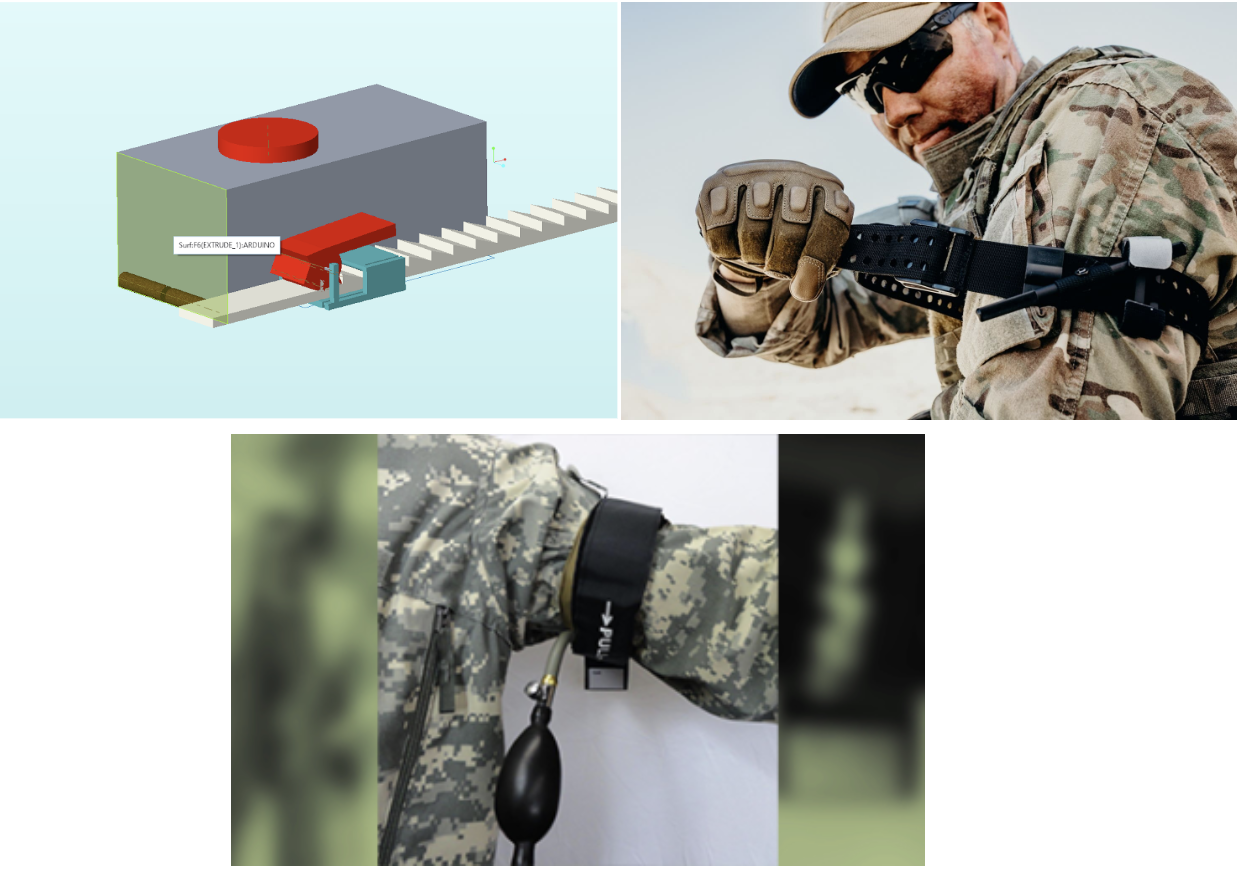Abstract
A self-tightening, quick application smart tourniquet allows for safer and faster application to the wounded in lethal environments, reducing the amount of time operators are exposed to gunfire or other dangers. The design will also facilitate much easier self-application, empowering operators to save their own lives, preventing others from getting injured in an attempt to treat them and reducing time between injury and application of tourniquet (this is especially true in the case of a mass casualty event). Furthermore, common user error is tightening a tourniquet too much, where manual tourniquet applications are overtightened by 91% on average, which can result in permanent tissue damage to the limb, even if the victim is saved (Dunn et al). Ultimately, an automatic, self-locking, quick application, smart tourniquet design has the potential to save countless military and civilian lives and limbs alike in the future.
Problem Statement
It's proven that prehospital use of tourniquets in both military and civilian environments dramatically increases odds of patient survival. In a study of injuries sustained by soldiers from 2003-2011, when a tourniquet was placed on an extremity wound, the soldier survived 96% of the time (Dunn et al). Therefore, it is important that tourniquet design is optimized for speed of application and for reliability. The design problem driving our work is as follows:
Can an automatic, self-locking, quick application, smart tourniquet be designed that provides operators with an effective method for controlling bleeding quickly without compromising reliability, and how can our tourniquet design facilitate operator self-application?
Proposal
The proposed device is an automatically tightening and self-locking smart tourniquet. It operates using an onboard suite of sensors and processors that use photoplethysmography to detect heart beat. The on board processor takes in this data, processes it, and uses a servo to tighten the tourniquet until the point where no heartbeat is detected, which is defined as the minimum force required to stop the bleed. The computing package also includes an onboard clock that will start a timer measuring the time that the tourniquet has been applied, allowing for accurate timing to assist medical personnel once the casualty has been extracted.
The crux of this design mimics the operation of a snowboard binding. The belt will be toothed, and will feed through a housing that allows only forward motion of the belt. A gear will be utilized to advance the belt, powered by a servo. A release will be included that allows the belt to be loosened to remove the tourniquet after use.
The entire suite of servos and processors will be housed in a rugged case, designed to United States Army specifications to ensure that it will function in the harshest of conditions, 100% of the time. Testing will be conducted to ensure reliability in various conditions, and data will be taken and analyzed on the average time to apply and activate the device. The goal is to produce a tourniquet that is close in weight to the commonly used Combat Application Tourniquet ®, that can be applied quicker.
Our team is aware of medical ecosystem concepts proposed by Army Futures Command. Such technology would allow commanders to see the health of their soldiers in real-time based on sensors embedded within their clothing. This smart-garment technology would even be able to apply pressure to part of the body that may have been wounded. We may look into how our tourniquet could interface with this ecosystem and provide units with another method of administering combat medicine and monitoring soldier health (South).
Challenges and Unknowns
Sensor technology
Photoplethysmography is commonly used to measure heart rate in products such as the Apple Watch. This technology is simple to use, only requiring a green light and photoelectric diode. The challenge is where to imbed the lights and receivers, and ensure that they are high powered enough to measure an arterial bleed. Furthermore, some photoplethysmography devices can only measure heart rates at a minimum of 20 BPM, whereas the automatic tourniquet needs to measure a 0 BPM case.
Reliability
Servo motors must be strong enough to pull the tourniquet band with the extreme force required to compress a human limb, while remaining small and portable. A large number of tests must also be conducted to ensure that the product is reliable and will function correctly every single time. There is no room for error in the life or death situation that will require the use of this device.
Durability
Material choice presents a unique issue in that it will need to be strong, yet flexible, while also interfacing with human skin in a way that will not cause lasting damage. Research will be conducted with the Princeton University Department of Material Science to select a material that will meet the required specifications. Additionally, all materials chosen will be stress tested in rugged conditions to ensure that they can withstand combat conditions.
Testing
Testing needs to be rigorous to ensure that the electronic tourniquet functions properly every time. This includes stress testing the device in rugged conditions, as mentioned previously, but also validating the sensor's ability to accurately detect blood flow, and when it is successfully occluded. The latter will prove difficult, since simulating blood movement through a limb for testing is highly complex.
Works Cited
Dunn, John C., et al. “US Service Member Tourniquet Use on the Battlefield: Iraq and Afghanistan 2003–2011.” Trauma, vol. 18, no. 3, July 2016, pp. 216–20. SAGE Journals, https://doi.org/10.1177/1460408616632026.
South, Todd. “Future Army medics will lean hard on new tech to help mass casualties” Military Times. 13 October 2022.

 OUSD Research and Engineering
OUSD Research and Engineering  West Point
West Point